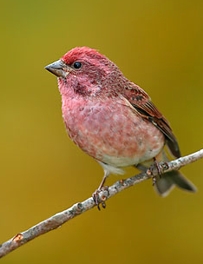|
||||||||||||||
| Carpodacus erythrinus (Pallas, 1770) |
Along
with purple finch, housefinch and Cassin's Finch, The common rose finch male displays a beautiful carmine red on the breast and lower back. Size: 15 cm weight: 21 gram. The wings are dark brown with two indistinct bars. The belly is white. The female is predominantly Olive brown with dark stripes and light belly.Youngsters of the c. rose finch a similarly coloured and marked. The young male wear in the first year a summer plummage, so they did not have any tinges of pink/red at all. The plummage is more warm buff, but the wing bars were very definately grey and well marked. It was initially identified by its call, which is a very flute like 'pleased to meet you'. The habitat of this pleasant species is the north east coastal area of europe, primarily however, central and north asia. In Mecklenburg and Rügen (Western Pomerania) are the primary breeding grounds. In west Germany and Switzerland the rose finch is occasionally seen. Wetlands and dense grassland must be present. His movements are similar to the bullfinch. His call is mainly loud whistles and twitters with pleasant trills like an oriole. Breeding:
Purple
Finch Carpodacus purpureus Description Length: 14-16 cm. Adult male: Head, back and breast rose red, brighter on rump; wings and tail dark brown, feathers edged with red; lower breast paler red, shading to white on belly. (This plumage is not acquired until the male is about two years old.) Adult female: Upperparts light olive-brown, streaked with dark brown; underparts white, boldly streaked with dark olive-brown, shading to white on belly. Breeding Nest: Composed of twigs and grass stems, rough exteriorly, lined variously with hair, fine rootlets, beard lichen when available, and occasionally wool from a sheep; usually placed near the top of a small or medium-sized spruce or fir in open woodland, sometimes so high as to be among the cone-bearing branchlets. Rarely it nests in deciduous trees, the nest saddled on a horizontal branch; apple trees in an orchard have been the only kind of deciduous tree used by this finch for nesting that I have noted. Eggs: 4-6, usually 5; blue, spotted sparsely about the larger end with black. These birds are rather late nesters, normally not laying until late May. Nest construction was noted on 12 May at Wolfville, and the earliest date for a complete set of fresh eggs is 30 May 1914. Of 13 nests examined, 7 contained five eggs, 5 contained four, and 1 held a set of six. The latest date for a set of first laying is 17 June 1913, the eggs slightly incubated. A nest discovered on Wolfville Ridge on 31 May 1915 contained five fresh eggs and was attended by what appeared to be two protesting females; it was later learned that one of them was a male in subadult plumage, an indication that first-year males breed. Range Breeds from northern British Columbia, northern Alberta, central Manitoba, southern Quebec, and Newfoundland, south to northern New Jersey, central Minnesota, southern Alberta and along the Pacific coast to Baja California. Winters from Nova Scotia, southern Ontario and southern British Columbia to the southern United States. Remarks The male Purple Finch's song and bright red plumage are notable characteristics. The name "Purple" is a misnomer, for the male is rose-coloured. His song in its fullness is a rich, rapidly enunciated, loud ecstatic warble, sometimes poured out in a torrent of melody as he hovers on outspread trembling wings. I heard one male attempt to sing very early in spring, but its tremulous, feeble rendition bore little resemblance to the song just described. At nesting time some bird species show a preference for locations close to human habitation—Tree Swallows and Yellow Warblers, for instance—but others have a strong opposite preference. The Purple Finch is quite impartial in this regard, building its nest just as often in our gardens as in remote forested areas. There is little justification
for confusing the male of this species with any of our other birds, except
possibly the House Finch, but the female is a different matter. She is
a heavily striped, grayish brown, sparrow-sized bird with a conspicuous
whitish line extending back from above her eye.
|
Sightings
in spring have been increasing for some years and by 1994 there were 5-20
pairs in England. Typically 1-7 pairs breed annually. |
 |






